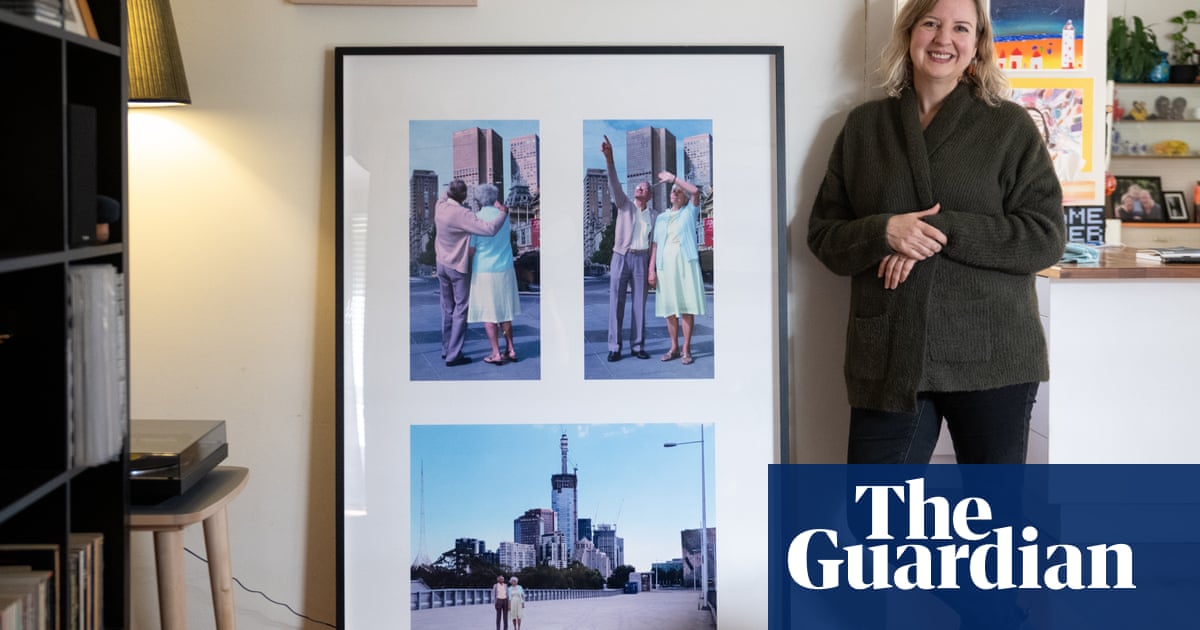
merica’s biggest “food forest” is just a short drive from the world’s busiest airport, Atlanta’s Hartsfield-Jackson, but there is a relative calm as you wander through the gravel paths that weave through its fertile 7.1 acres (2.8 hectares).
When the Guardian visits the Urban Food Forest at Browns Mill there are around a dozen volunteers working on a warm morning. Among them are a mother and son clearing weeds from a secluded area soon to become a yoga and meditation space. “I wanted to help,” Rina Saborio said. “I thought it was a really cool opportunity for the community.”
Hundreds of volunteers have come before them in Atlanta, and thousands at similar schemes across the US.
Food forests are part of the broader food justice and urban agriculture movement and are distinct from community gardens in various ways. They are typically backed by grants rather than renting plots, usually rely on volunteers and incorporate a land management approach that has a focus on growing perennials. The schemes vary in how they operate in allocating food and policies on harvesting, but they are all aimed at boosting food access.
Organizers in Atlanta stress that they properly distribute the food to the neighborhoods that the food forest is intended to support and it’s not open to the public beyond volunteer workers. Other schemes have areas where the public is free to take what they want.
Atlanta’s Urban Food Forest opened in 2019 with a plan to be a model for urban agriculture and to increase food access, a challenge that long predates the pandemic but which has been terribly exacerbated by the economic crisis caused by Covid-19.
This scheme is located in Atlanta’s southside Lakewood community, less than five miles from downtown. Lakewood is a food desert, as defined by the USDA, and the nearest grocery store with healthy food options takes 20 minutes via public transportation. Most nearby “food marts” offer far more sweets, processed foods, and canned goods than fresh fruits, vegetables and produce.
Celeste Lomax, who manages community engagement at the Brown Mills forest and lives in the neighborhood, believes education is key to the forest’s success and beams like sunlight when sharing her vision for the fertile soil she tends. “We’re using this space for more than just growing food. We have composting, beehives, bat boxes, and this beautiful herb garden where we’re teaching people how to heal themselves with the foods we eat. We’ll be doing walkthrough retreats and outside yoga. This is a health and wellness place. It’s so much more than just free food.”
The land, once owned by a pecan farming family, sat vacant for years and almost became a multi-family housing unit after being purchased by developers in 2000. It was acquired by the city in 2016, through a partnership with Trees Atlanta and The Conservation Fund, and a grant from the USDA Forest Service’s Community Forest and Open Space Conservation Program.
Food access has been a long-term challenge in the city. According to a June 2017 report in the Atlanta Studies journal, food insecurity rates were above 25% in downtown Atlanta and nearby in southern Fulton and DeKalb counties, where residents are mainly people of color with lower incomes. In Atlanta Regional Commission’s annual Metro Atlanta Speaks survey, 18% stated they received food bank assistance since March 2020.
Before the pandemic, Lomax had enough herbs of all types, to give volunteers tea packs for homebrewing after a day’s work. Today, the volunteer maximum is set at fifteen people, but back then as many as fifty volunteers worked the forest on scheduled days. She is hopeful that there’ll be enough catnip, lemon balm, chocolate mint, and other herbs to keep up with demand as members of the community near and far come back to help. “Once this stuff grows, and I can start giving things away again, I’ll be blessing the volunteers. They call it sweat equity; I call it blessing those who bless us.”
‘A living system’
Some 35.2m people lived in food-insecure households throughout the US according to a report by the US Department of Agriculture in 2019. Last month a Guardian/Northwestern University investigation showed the scale of the crisis in the past year with one in four facing food insecurity before Christmas, amounting to some 81 million people. It also highlighted the racial divide in the food system with Black families reported to be facing hunger four times more often than white families.
The Dr George Washington Carver edible park in Asheville, North Carolina, was the first public food forest to open in the US, back in 1997. Since then, many more have emerged around the country, and though there is no official data, according to the non-profit Sustainable America, as of 2018 there were more than 70 public food forests in the United States.
As Mark Bittman writes in his book, Animal, Vegetable, Junk, urban gardens, farms and food forests “can’t compare in scale, appearance, or yield to large rural farms but by supplying populations with real food, and bringing power and understanding of food systems to urban eaters, they become important pieces of the puzzle.”
As defined by expert Michael Muehlbauer, Orchard Director at the Philadelphia Orchard Project who is currently working to bring a food forest to public land in Philadelphia, food forests “are a gardening technique or land management system, which mirrors and works with woodland ecosystems by incorporating trees, shrubs, perennials and annuals that produce human food. This creates a living system with numerous benefits including wildlife habitat, resilient biodiversity, an abundance of food and medicinal yields, carbon sequestration, increased urban tree canopy, local food security, and an opportunity for community gathering and education.”
Muehlbauer was one of the very first volunteers at the Beacon Food Forest in Seattle. It began back in 2009 when four friends from the neighborhood of Beacon Hill came together to transform a seven-acre plot of public land into an ecosystem that could provide local food to neighbors.
Elise Evans, a long-time volunteer and former board president of Food Forest Collective, the nonprofit that manages the Beacon Food Forest, shared that the forest has helped in many ways with food insecurity.
“We’re not a food bank,” she clarified, “but we do something unique where we empower people to show up. We accept all volunteers who are kind and want to have a sense of purpose in growing food together. It’s sort of a large-scale demonstration site. Anyone can do this in their ecosystem and we’re showing them how that can be done.”
The Beacon Food Forest in Seattle is mostly an open harvest site. Except for areas designated as food bank plots and City of Seattle P-Patches, they allow free foraging on-site. Over the past eleven years, they’ve seen successful results and haven’t observed anyone “wiping out” a harvest. Evans said: “In the golden hour of the evening, we see many people on site harvesting food for their dinner or food for a neighbor. They get to harvest something and walk two blocks away to go home and have dinner.”
The role of community and volunteers is crucial to keep these initiatives going. And Evans knows this from personal experience. She first became involved in the Beacon Food Forest after attending the first “ground making party”, a monthly community gathering that pre-Covid that would attract more than 100 people of all backgrounds to work on the forest while enjoying pots of soup and salads picked from the site.
“It was a glorious communal experience,” she recalled. “At first I thought I would learn about permaculture, but in the end, it was a vivid experience with energy from people of all backgrounds. So I ended up making friends and stayed for the people, which is a story of many people at the Beacon Food Forest.”
J Olu Baiyewu, Urban Agriculture Director of the City of Atlanta, says that as urban agriculture installations continue to come into communities, digging more deeply into community engagement and outreach is essential: “I think what has become clearer for everyone involved is the need for a continuous community engagement beyond the visioning plan, continuous kind of check-ins,” he said.
Yet, consistent community engagement comes with challenges of its own. There are issues of governance, organizing and commitment to be sorted out, and as projects grow, these matters become increasingly complex.
Muelhbaur, who has worked for the past five years to bring a food forest to public land in Philadelphia, emphasized that “challenges for public food forest projects include volunteer burnout, as it can be quite a bit of work to organize these projects, which often fall on the shoulders of passionate volunteers Finding the right structure is important to keep the project organized.”
Citing his experience with the upcoming food forest, he added, “it’s taken five years of community organizing, talking to the city, making sure we have the right insurance policy in place, and negotiating a lease”.
As Evans put it, many volunteers are driven by wanting a change from large mono-crop agriculture. And aside from knowing where their food comes from, they want to know their neighbors. “In a world that’s increasingly digital and stressful, it’s consistent that we need community and this provides that. It’s nourishing both for our bodies and our hearts to show up to this space.”
‘This is so much bigger than us’
“This is good for stomach ailments,” Lomax recommended, speaking to one of the Atlanta volunteers about anise growing near lavender. “It’s good for insomnia, so I would use this in a tincture and also in a tea.”
As she continues explaining the potential of the forest, including her excitement about meeting a volunteer earlier in the day who offered to lead a cooking class on the property using herbs and produce grown in its dirt, Rina Saborio walks over to say goodbye after finishing her day of volunteering. In her hand is a bunch of chives she’s carefully uprooted from the area she and her son were clearing. She offers them to Lomax, who says she can keep them in exchange for her service.
“This is so much bigger than us,” Lomax said. “We thought we were just gardening but it’s grown to be so much more. It’s like a place of healing. I’ve had a lady cry because she was able to release stress in this place. That’s when I said, “Wow, this place is really magical. It takes a village to raise a child but it takes a community to change the world.”












